Starting Meditation in Retirement: A Journey of Inner Peace

Embarking on a new chapter, many seniors discover that Starting Meditation in Retirement offers a profound pathway to tranquility and purpose.
Anúncios
This phase of life, often marked by increased free time, presents an ideal opportunity to cultivate mindfulness and enhance well-being.
The transition from a busy professional life to retirement can sometimes feel disorienting. Meditation acts as a steady anchor during these shifts.
It’s a practice of presence, not performance, perfectly suited for the relaxed pace of retired living.
Embracing the Quiet: Why Now is the Time
The urgency of deadlines and the noise of the working world often overshadow the inner voice. Retirement finally allows for the space to listen.
Anúncios
This newfound availability of time is a precious gift for self-discovery. Many retirees seek meaningful ways to fill their days beyond leisure activities.
Meditation provides deep engagement without physical strain. It’s an investment in mental and emotional resilience for the years ahead.
Learning to simply be can be the most productive task of the day.
Anúncios
Beyond the Mat: Defining Your Practice
Meditation isn’t about clearing your mind completely; that’s a common misconception. It’s about gently focusing attention, often on the breath or bodily sensations.
For seniors, finding a comfortable position is key, whether seated on a chair or lying down.
The goal is consistent, gentle practice, not achieving some mythical state of enlightenment.
Even five minutes daily can initiate significant changes. Think of it as mental calisthenics, strengthening your ability to focus and relax.
The Science of Serenity: Real Benefits for Seniors
The advantages of a regular meditation practice are increasingly supported by science. Starting Meditation in Retirement can directly impact physical health.
It is known to help manage chronic stress and lower blood pressure.
Read more: How Seniors Can Use Meditation to Stay Positive and Grateful
A study published in the Journal of Behavioral Medicine indicated that mindfulness meditation can significantly reduce symptoms of anxiety and depression in older adults.
This practice supports cognitive function by enhancing attention and concentration. Furthermore, better sleep quality is a frequently reported benefit among meditators.

Cultivating Presence: Simple Techniques to Begin
A great way to begin is with Mindful Breathing, focusing solely on the sensation of air entering and leaving the body.
Another effective method is the Body Scan, systematically bringing attention to different parts of the body.
This helps connect mind and body, often revealing areas of tension.
See how interesting: A Senior’s Guide to Mindful Walking Meditation
You could also try Walking Meditation, mindfully aware of the feeling of your feet touching the ground.
Integrating these short moments of awareness into your day builds a foundation for longer sessions.
Remember that every time your mind wanders, and you gently bring it back, you strengthen your focus muscle.
Overcoming Initial Hurdles with Grace
Many beginners feel frustrated because their minds are busy—this is perfectly normal. The mind is designed to think, so don’t view wandering thoughts as failure.
Instead, consider them opportunities to practice non-judgmental awareness. Consistency, not duration, is the vital ingredient for success.
If you skip a day, simply start again the next, without self-criticism. Establishing a routine, such as meditating immediately after breakfast, promotes adherence.
Analogies for Understanding the Journey
Think of your mind like a snow globe that has just been vigorously shaken. Initially, the “snow” (your thoughts, worries, and plans) swirls chaotically.
Meditation is the act of gently setting the globe down. You don’t try to force the flakes to settle.
You simply wait, observing as the contents gradually drift and settle to the bottom, revealing clarity.
This patient observation is the essence of the practice. Isn’t that a beautiful, practical way to approach inner quiet?
A Personalized Path Starting Meditation in Retirement
Consider Eleanor, 72, a former accountant, found her mornings dominated by financial worry even in retirement.
She began 10 minutes of sitting meditation focusing on the sounds around her. After three months, she reported a significant decrease in morning anxiety, replacing worry with quiet observation.
Check this out: Chair Yoga vs. Traditional Yoga for Seniors: Which is Best?
Robert, 68, a retired teacher, used to rush through his meals. He started a daily mindful eating practice, savoring each bite.
This simple shift extended his newfound patience to other areas of his life, proving that Starting Meditation in Retirement transforms everyday moments.

The Community Aspect: Sharing the Journey
While meditation is a solitary practice, sharing the experience can be deeply motivating.
Joining a local seniors’ meditation group or an online community provides valuable support and guidance.
Hearing others’ experiences normalizes the challenges and celebrates the small victories.
The shared intention creates a powerful, positive ripple effect. It reminds us that we are all navigating the journey together. This sense of belonging reinforces the personal commitment.
A Look at the Data
According to the National Health Interview Survey (NHIS) data from 2022, the use of meditation among adults in the U.S. has notably increased across all age groups, with significant growth observed in the 65 and older demographic.
This trend confirms the current relevance and growing adoption of the practice among seniors seeking holistic health approaches.
Furthermore, the benefits of Starting Meditation in Retirement extend into areas like pain management, as numerous studies have indicated the brain’s ability to modulate pain perception through mindfulness training.
Your Next Step to Inner Calm Starting Meditation in Retirement
The decision to embark on this inner journey is the most crucial step. It’s an affirmation that your peace of mind deserves attention and care.
The beauty of Starting Meditation in Retirement is that you have the time and wisdom to commit fully. Remember, the goal is not to stop thinking, but to realize that you are not your thoughts.
This realization brings incredible freedom and lightness. What better way to spend this vibrant new chapter than by cultivating profound inner peace?
Frequently Asked Questions
How long should a beginner meditate?
Start small, perhaps just 5 to 10 minutes daily. Consistency is more important than duration. You can gradually increase the time as the practice becomes more comfortable.
Do I need special equipment to start meditating?
No special equipment is necessary. Simply find a comfortable, quiet place where you won’t be disturbed for a few minutes. A comfortable chair or cushion is often all that’s required.
What if my mind keeps wandering during meditation?
A wandering mind is completely normal. The practice involves noticing when your mind has wandered and gently bringing your attention back to your anchor (like the breath) without judgment.
This gentle return is the core of mindfulness training.
Is meditation a religious practice?
While meditation is a component of many religious traditions, the practice of mindfulness and concentration techniques used for well-being is entirely secular and available to everyone, regardless of their beliefs.
